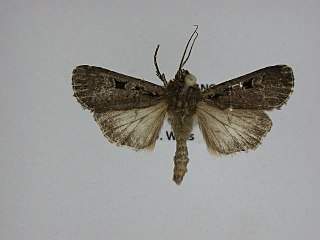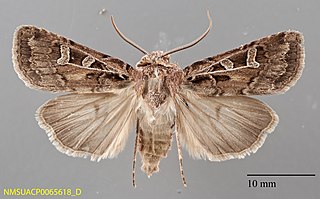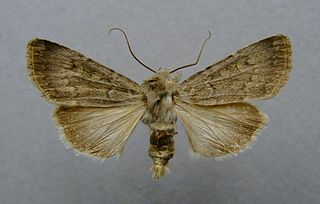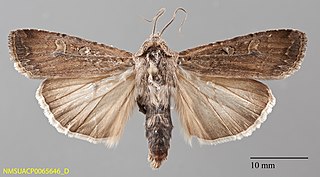
The garden dart is a moth of the family Noctuidae. It is distributed throughout much of the Palearctic. Temperate regions of Europe, Central Asia and North Asia, as well as the mountains of North Africa. Absent from polar regions, on Iceland and some Mediterranean islands, as well as in Macaronesia.

Euxoa nigrofusca, the white-line dart, is a moth of the family Noctuidae. It is found from Europe, to southern Siberia, central Asia to the Pacific Ocean. In North Africa it is known from Morocco and Algeria.

Euxoa obelisca, the square-spot dart, is a moth of the family Noctuidae. It is found in the Palearctic realm.

Euxoa is a genus of moths of the family Noctuidae raised to Genus by the German entomologist, Jacob Hübner. The Genus is mostly confined to dry and semi dry areas in the Northern Hemisphere. There 130 species in Eurasia, a few in Africa, and 175 in North America. There are no species in the Genus in South-East Asia or in Australia. In North America, most species are found in Western regions. Of the North American species, 4 are endemic to Mexico. There is one species recorded from Chile, but this may be a mislabeled specimen. In real terms, species numbers do not equal species abundance. Some areas with few species have large numbers of the ones that do live there.

Euxoa messoria, the darksided cutworm or reaper dart, is a moth of the family Noctuidae. The species was first described by Thaddeus William Harris in 1841. It is found from Newfoundland west to Yukon, south to Virginia and Missouri in the east and New Mexico, Arizona and California in the west.

Euxoa cursoria, the coast dart, is a moth of the family Noctuidae. It is found in northern and central Europe as well as the coastal regions of the British Isles, central Siberia, Mongolia, Tibet and Afghanistan. The subspecies Euxoa cursoria wirima is found in Canada.

Euxoa medialis, the median-banded dart, is a moth of the family Noctuidae. The species was first described by Smith in 1888. It is found in North America from southern Manitoba and central Wisconsin, west to southwest Alberta and California; north to southern Alberta and south to south-central Mexico.

Euxoa recussa is a moth of the family Noctuidae. The nominate form is found in mountainous areas in Southern Europe as well as the Alps. Euxoa recussa tetrastigma is found Northern Europe, east to Russia, Western Siberia, the Altai Mountains and Amur.

Dichagyris acclivis is a moth of the family Noctuidae. It is found from southern Ontario and southern Massachusetts south to eastern Tennessee and western North Carolina, west to Illinois, Missouri, and Kansas and south to east central Texas. It is listed as a species of special concern in Connecticut.
Euxoa bostoniensis, the Boston dart or drab cutworm, is a moth of the family Noctuidae. It is found from Ontario and Maine to North Carolina, west to Missouri, north to Michigan. It has also been recorded from Florida, California and South Dakota.
Euxoa campestris, the flat dart, is a moth of the family Noctuidae. The species was first described by Augustus Radcliffe Grote in 1875. It is found in North America from Newfoundland to Alaska, south to New England and southern Canada from southern Quebec west to British Columbia. In the west it is distributed southward in the Rocky Mountains to southern New Mexico, east-central Arizona, and central Utah. In the east it occurs in the Appalachians in eastern Kentucky and in western North Carolina.

Euxoa tessellata, the tessellate dart or striped cutworm is a moth of the family Noctuidae. It is the most widespread Euxoa-species in North America. It is found from Newfoundland to Alaska, south in the west to California, Arizona, New Mexico, south in the east to Florida. It seems to be absent from Texas and adjacent eastern states.

Euxoa adumbrata, the sordid dart, is a moth of the family Noctuidae. The species was first described by Eduard Friedrich Eversmann in 1842. In North America it is found across northern Canada from Quebec to western Alaska, south to the northern parts of the United States, and in the mountains to Colorado. It is also found in Greenland, the coastal areas of Scandinavia and the Ural. It was recently recorded from Denmark, although this includes Euxoa lidia, which some authors regard to be a valid species.

Euxoa divergens, the divergent dart, is a moth of the family Noctuidae. The species was first described by Francis Walker in 1857. It is found in North America from Newfoundland to Alaska, south to New York and Michigan in the east, and in the mountains of the west, south to New Mexico, Arizona and California.
Euxoa dargo is a moth of the family Noctuidae first described by Ferdinand Heinrich Hermann Strecker in 1898. It is found in North America from south-eastern Manitoba west to the southern interior of British Columbia, south to Oregon, southern Idaho and northern New Mexico, and east to eastern South Dakota.

Euxoa decora is a moth of the family Noctuidae. It is found in southern and central Europe, Morocco, Algeria, the Caucasus, Armenia, Issyk-Kul, Turkey, Iran and Iraq.

Euxoa ochrogaster, the red-backed cutworm, is a moth of the family Noctuidae. It is found from Iceland and northern Europe, through the Baltic to the Amur region. In North America, it is found from Alaska to Newfoundland and Labrador, south into the northern part of the United States, south in Rocky Mountains to Arizona and New Mexico.
Euxoa violaris, the violet dart moth, is a species of moth native to North America. It is listed as a species of special concern in the US state of Connecticut. It was described by Augustus Radcliffe Grote and Coleman Townsend Robinson in 1868.
Euxoa oberfoelli, or Oberfoell's dart moth, is a species of cutworm or dart moth in the family Noctuidae. It is found in North America.

Euxoa inconcinna is a species of cutworm or dart moth in the family Noctuidae. It is found in North America.














